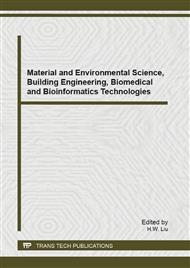p.590
p.594
p.598
p.607
p.611
p.615
p.619
p.623
p.629
Study on Apoptosis of Human Promyelocytic Leukemia HL-60 Cells Induced by Fucosterol via Mitochondrial Pathway
Abstract:
The purpose of this study is to investigate the effect of fucosterol on the induction of apoptosis and the molecular mechanism involved in Human promyelocytic leukemia HL-60 Cells. HL-60 Cells were treated with different concentrations of fucosterol at different time. MTT method was used to study fucosterol anti-tumor activity. Morphology observation was performed to determine the effects of fucosterol on apoptosis of HL-60 cells. Flow cytometry (FCM) was used to detect the cell cycle. Laser scanning confocal microscope (LSCM) was used to analyze mitochondrial membrane potential (MMP). Western blot was performed to analyze the expressions of Cyt-C, Caspase-9 and Caspase-3. The results showed fucosterol could inhibit the growth of HL-60 cells, and the apoptosis morphology for 48 h treatment was obvious, which showed cell protuberance, cytoplasm concentrated and apoptotic body. Fucosterol treatment for 24 h decreased MMP in dose-dependent manners. It also induced the release of Cyt-C and the activation of Caspase-9 and-3. In conclusion, Fucosterol could induce HL-60 cells apoptosis through a mitochondrial pathway.
Info:
Periodical:
Pages:
611-614
Citation:
Online since:
September 2013
Authors:
Price:
Сopyright:
© 2013 Trans Tech Publications Ltd. All Rights Reserved
Share:
Citation:


